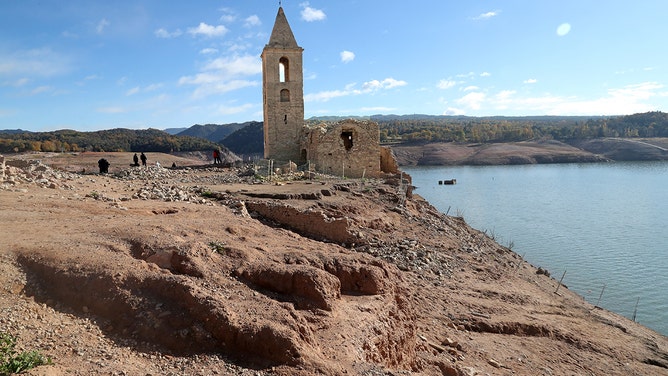'Exceptional' drought reveals ancient Spanish village
The Sant Salvador de la Vedella Benedictine monastery in Catalonia, Spain, was built in 830. It’s the only building of the ancient village of Sant Salvador de la Vedella left standing. In 1976, the town was flooded by the Baells reservoir.

People visit Sau reservoir in conditions of extreme drought in Vilanova de Sau, Spain on April 7, 2023. The drought in Catalonia due to the lack of rain in recent months has caused the water reserves of many swamps in the area to reach critical levels, a fact that has caused the government to impose water restrictions.
(Adri Salido/Anadolu Agency / Getty Images)
Photos of an exposed ancient monastery in Spain highlight just how critical the country’s drought has become.
The Sant Salvador de la Vedella Benedictine monastery in Catalonia, Spain, was built in 830. It’s the only building of the ancient village of Sant Salvador de la Vedella left standing. In 1976, the town was flooded by the Baells reservoir.
Since then, the monastery has typically been surrounded by water, reachable by kayak when the reservoir is full and by foot when it’s low. Now, the reservoir is completely bare. The "shocking" images from the Catalan Water Agency are a grim reminder that "we are in the phase of exceptionality," the agency said.
A 2017 Instagram post shows what the remarkable monastery looks like when it's surrounded by water.
TEXAS TIKTOK GRANNIES TRAVEL THE WORLD IN 80 DAYS
Drought levels in Spain reached "exceptional" levels in March, threatening access to drinking water for 6 million people in the Barcelona metropolitan area.
In Catalonia, about 75 miles north of Barcelona, the situation is critical, as average reservoir levels hover around 27% of their capacity. There are restrictions on agricultural and industrial water use, and it is forbidden to use drinking water for washing cars or filling swimming pools.
OLIVE OIL PRICES CLIMBING AFTER HEAT, DROUGHT IN EUROPE LEADS TO POOR HARVEST, SHORTAGE

The Sau swamp, in the Osona region, is at an all-time low, at 19% of its capacity. The water level has dropped to the point of fully emerging the Romanesque church of San Roma de Sau, as well as other buildings of the old town, as shown in the photo of 29th 2022.
(Joan Valls/Urbanandsport /NurPhoto / Getty Images)
Meanwhile, Spain as a whole has warmed 1.3 degrees Celsius (2 Fahrenheit) since the 1960s, the Associated Press reports. It's a phenomenon that is noticeable all year round but especially in summer — when average temperatures have risen by 1.6 degrees.
The Associated Press contributed to this report.